Anatomy of A Murder: The Art of Observation
Otto Preminger’s Anatomy of a Murder is more than just a film dealing with the court system: it stands as a realistic and meticulous observation of American life at the time. It was adapted from John D. Voelker’s novel that he had based on a real story in which he was the defence attorney, and Preminger was careful to depict the affair close to how the real case had been conducted. The theme of observation is developed in every aspect of the film. The director aimed to observe and depict the legal system in a scientific and realistic way. In the story, characters observe each other and all are aware that the way they appear will build a specific image of them, and will impact the way they are judged in the trial. Finally, the theme of observation is also developed in the film’s style through Preminger’s observing camerawork which encourages the audience to examine every detail in the film in order to construct their own opinion and meaning of the case, like a real jury
An insight into American Justice
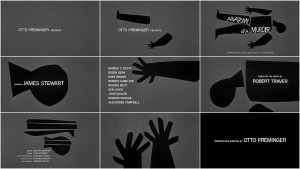
Anatomy of a Murder examines the American judicial system almost scientifically. Like a scientist, Preminger chooses a specific case to observe to understand the strengths and flaws of American justice. Through observation, spectators are asked to act like scientists – they have to examine evidences and observe people to draw their own conclusions on the case. Even the film’s title invites us to observe the trial in a scientific way, ‘anatomy’ relating to the biological study of body parts and their interactions. The murder is like a body that has to be dissected. In the opening credits, the camera zooms in and out on the individual body parts that appear on screen. This visual metaphor suggests the film performs an autopsy on the court system, observing it and breaking it down to understand the truth behind the murder and the inner workings of American justice. Therefore the recurrent theme of scientific methodology translates Preminger’s desire to address the film with a methodical mind just like the characters do with the trial, and to encourage the audience to do the same.
The characters in the film also address law with scientific methods of observation. Attorneys build their cases by examining their witnesses, questioning their motivations and addressing inconsistencies in their stories. In his article, Nick Pinkerton 1 states that throughout the film, Biegler (James Stewart) and Dancer (George C. Scott) quibble to choose the right word to convey their preferred versions: ‘opinion rather than fact, evening walks rather than prowls.’ This importance of having the right word to express the right notion is similar to scientific reports where each word is weighed against the other to convey results in the most truthful way. The difference between a casual ‘evening walk’ and a ‘prowl’ is crucial to understand the intentions behind Laura Manion’s (Lee Remick) walk: one makes her an innocent victim while the other suggests she was walking like a ‘predator in search for a prey’. Hence meticulous observation and formulation are essential to figure out the motivations of the victim in the trial. The fact that Preminger took time to show Biegler and Dancer fight over the exactitude of words illustrates the director’s will to depict the legal system fully, without cutting out minor details. His film is as scrupulous as a judicial procedure and offers a realist portrayal of the legal system, a world that Preminger knew, having observed it for many years.
Anatomy of a Murder presents us with a very detailed picture of the judicial structure, a picture that Preminger himself had experienced as he earned a law doctorate and his father was an attorney. The director was very careful to depict the system he knew well in a truthful and realist way for the audience to get as close as possible to the heart of their legal structure. Pinkerton writes that the verisimilitude of the film:
‘can be attributed to Preminger’s working from the story of a real-life trial; his perennial devotion to location shooting which took him to the scene of the crime; and his wallflower mise-en-scène, which observes action at arm’s length, without imposing interpretation on the viewer.’
Here, Pinkerton points at the realism of the film and stresses how it observes the events ‘at arm’s length’ (objectively and with distance) which gives credibility to Preminger’s portrayal and allows spectators to create their own meaning. In his ongoing quest for realism, Preminger shot the film close to where the real murder had occurred which suggests that he had the chance to observe the setting and provide a close-to-reality picture of the murder. He also asked the head counsel for US Army Joseph Welch to be the judge, and members of the jury panel from the original trial to sit on the set. This adds a layer of reality to the film that makes its depiction of the court system even more reliable. By choosing location shooting and actors that knew the legal world inside-out, the director brought authenticity to his film and worked like an attorney – he went to the crime scene, observed the town and used his legal knowledge to create a film that the audience can trust. It is through the work of observation and by the attention paid to real-life facts that Preminger managed to document the legal system authentically.
The Importance of Facts
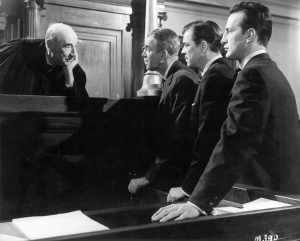
Facts are presented in the film as key elements to create meaning and understand what happened on the night of the murder. The act of seeing, observing or witnessing events seems to be crucial in categorising evidences as facts or as lies. When Biegler first meets Lieutenant Manion (Ben Gazzara), he asks him if he saw Barney Quill raping his wife. The fact that Manion has not seen the rape makes us question its realness and underlines the importance of witnessing in the search for truth.
Seeing seems more reliable than memory – when Manion describes to the court how he lost all awareness of what he did after the murder, the only way he realized he had shot Quill was the vision of the gun: ‘I saw the gun, noticed it as empty.’ By observing the gun, he linked its emptiness to its use on Quill, potentially by himself. Observation and the act of seeing leads to the construction of meaning. This is also the role of experts called at the bar in the trial like the photographer or the psychologists – they share their observations and expertise to help distinct facts from lies. Their jobs imply thorough observation, whether it means taking pictures of places or examining someone’s behaviour and psychological state. This again demonstrates that meaning can be achieved by sharing observations and asking experts for their knowledge and distanced comprehension of the events.
Biegler is aware of the importance of thorough observation – his vision of the law is procedural and rational, like science, where observation leads to facts therefore constructs knowledge. His whole procedure is based on observation; for example, he goes to the bar where Barney Quill worked and takes a close look at the photographs and newspaper clips hanging on the wall; when he goes behind the bar, he notices a space where a gun could be kept. This suggests that Quill could be a violent man and shows how Biegler, by examining clues, can start drawing meaning from them and make assumptions on what happened. He also goes to the library to build the case on solid facts and make it more reliable. Books hold a status of knowledge, especially in law – rules and laws are written in books, applied from books. They allow to create meaning, compare cases, draw conclusions. Yet books do not hold all the answers, can often be biased and do not represent absolute truth. Observation of people and their behaviours is another way to create meaning, perhaps access ‘truth’ about cases, as unreliable and subjective as it may be.
Observing the People
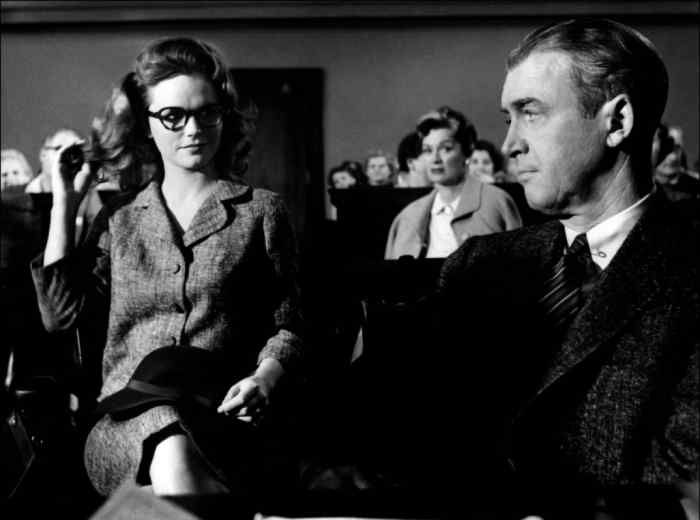
Most of the decisions taken in court are based on the observation of people. A jury will feel more drawn towards someone who appears truthful, coherent and morally strong than someone who seems ‘corrupt’, unsure or uncomfortable, even though the whole experience of a trial can be extremely daunting. A jury will therefore create their own opinion about victims and suspects after having observed them in trial. Biegler is very aware of the influence of appearances on jury decisions and asks Laura to hide what is deemed ‘provocative’ in her, and to appear ‘decent’ and ‘trustworthy’. In court, she trades her sunglasses for a classic pair. The sunglasses represent her glamorous sense of fashion and make her look mysterious. They are a protection – if the eyes are the windows to the soul, then to hide them is a way to prevent people from looking too deep, and maybe perceive her frailty, or her true unhappiness. In the trial, her other glasses make her look so-called ‘decent’ and the clear lenses suggest that she has nothing to hide. This shows how shaping your appearance for trial is key in a space where people will observe everything you do and judge you by the way you look and behave.
Yet Laura doesn’t seem uncomfortable or outraged; she almost seems to take pleasure in being the centre of the court’s attention, portrayed in a ‘femme fatale’ fashion. She is fully aware of her attractive appearance and encourages people to look at her. Why would her appearance define who she is, her values, her intentions? Why would it define her motivations in the case, and somehow be used against her to discredit her position as victim of a rape?
When Biegler questions Laura in his office before the trial, she says Biegler looks at her a certain way and he replies that ‘it would be difficult not to look at you’. He even asks her if she was wearing a ‘girdle’ at the time of the rape, an object charged with sexual connotations and seduction. Again, this objectifies her as a ‘sexual creature’, highlights her ‘flirtatious’ nature, which Biegler feels would impact the jury’s understanding of the case. This is problematic – somehow Biegler questions her intentions, her consent, based on her appearance and behaviour, therefore doubts she is telling the truth about her rape. Is this indicative of how men perceived women who are confident about their looks? Why would Laura’s sexual confidence discredit her as victim of a rape? Why would it mean that somehow, she manipulated the case, or worse ‘brought in’ on to her? In this light, it seems Biegler is paying too much attention to Laura’s looks, and makes more assumptions than factual observations. Or at least he is aware that this is what the jury and the judges would perceive. In that sense, seeing does not always mean getting to the ‘fact’ or the ‘truth’ in a neutral way, but is embedded in people’s individual beliefs, views, and in society’s codes. Biegler’s assumptions seem muddled with the gender politics and sexist views of the time, and he may not be as procedural and rational as we would think. Hence the audience is invited to also observe Biegler and the attorneys, and make their own judgement.
Biegler also tries to change Lieutenant Manion’s behaviour in order to better defend him. Manion appears to be a tough man with a bad temper who cannot control his anger easily. When he first meets Biegler, he does not look ready to cooperate. Cigarette in hand, unbuttoned shirt and a low, rough voice, he appears more like a ‘bad boy’ type than a lieutenant and instantly gives the audience the impression of someone who must not be hassled with. His bursts of anger during the trial convey his violent personality and undermines Biegler’s effort to make the murder look like an involuntary and unconscious impulse rather than a premeditated act. If he easily loses his temper in court, how would he have reacted in front of Quill after the rape? Was it really an unconscious act? The importance of how the Lieutenant looked the night of the murder seems crucial in evaluating his state of mind, whether he was temporarily out of control or determined to shoot Quill.
In the trial, the prosecution asks Al Paquette (Murray Hamilton), who witnessed the murder, how Manion appeared to him and if he was in ‘complete possession of his faculties’ to which Paquette replies yes, that Manion ‘walked slow, kind of deliberate’ and was ‘cool and cold.’ This undermines the argument of a temporary loss of control as Paquette seems to have observed Manion’s behaviour in detail and states that he appeared lucid and determined. This shows again how paying attention to people’s appearances leads to making assumptions and creating meaning. A trial and a film are similar in that way – like the jury, the audience has to observe the characters to understand the circumstances of the murder, and it is Preminger’s camera work that invites us to observe and create our opinion of the case. We are the jury of the film.
An Investigative Camera
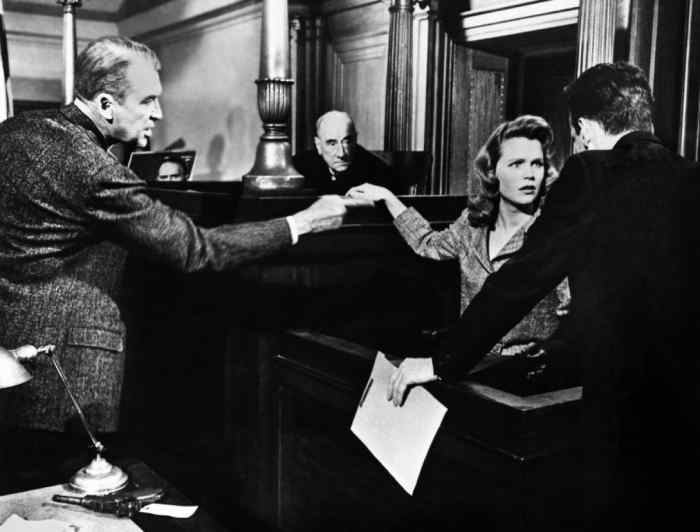
Preminger’s camera work and stylistic techniques place the audience at the heart of the trial. The observing camera follows the characters and scrutinises the places like a spy which allows us to see everything in detail. John Orr states that Preminger’s panning and travelling shots ‘allow the spectator to enter into the picture, an opening up of cinematic space’ 1. By not forcing the eye of the viewer and keeping his camerawork reserved of any judgement, he breaks the space between screen and audience and encourages us to participate in the investigation of the murder. His style incites us to observe meticulously the scenes and the protagonists’ behaviours in order to link clues together, make assumptions and construct our opinion of the case.
As Susan White writes, Preminger ‘presupposes an intelligence active enough to allow the spectator to make connections, comparisons and judgements. Preminger presents the evidence but he leaves the spectator to draw his own conclusions’ 2. By adopting a neutral camera style and allowing the witnesses to recite their versions without judging them, Preminger creates the perfect conditions for viewers to observe how a trial functions and make their own moral judgement about the way the characters behave and the meaning of their actions.
In the hands of the impartial director, the camera is like a window into the film. Windows are a recurrent motif that highlights the theme of observing and being observed. When Biegler comes home from his fishing trip at the beginning of the film, his friend Paul McCarthy (Arthur O’Connell) pays him a visit and checks if Biegler is here by looking at the window. The camera stands behind McCarthy and directly looks through the window where we can see Biegler on the telephone in the background. The camera becomes a sort of character watching from behind and instantly positions the viewer as a direct observer of the scene, as if we were there.
Another example of this happens when Biegler is about to interrogate Manion for the first time. He opens the door to the Sherriff’s office and lets Manion in before closing the glass door. As he closes the door, the camera, which stood completely still before, moves forward and tracks Biegler through the window. Preminger could have simply cut to the inside of the room but through this technique, he makes the camera look alive and imitates the steps of someone watching by the door. Consequently, it feels like we are spying on them – Preminger invites us to observe the scene and prevents us from missing clues that could impact our understanding. Hence the film’s camerawork highlights the importance of observing every detail to create meaning.
Long takes also encourage the audience to be thorough observers as it gives time and space for spectators to look at the scenes in detail. When Biegler goes to the bar where Quill worked, he takes time to look at each corner of the room and the long take allows the audience to follow him in his investigation. It gives us an idea of how much time he pays observing each detail in the bar. After looking at the photos on the wall, he moves away from us and after a moment, turns back to face us with an inquisitive look on his face, as if he had found something. Instead of cutting to the object of his interest, the camera tracks his movements until he reaches the bar and the audience discovers what he was looking at. This creates suspense and suggests that, like Biegler, we need to take our time to observe and create meaning from the clues we examine.
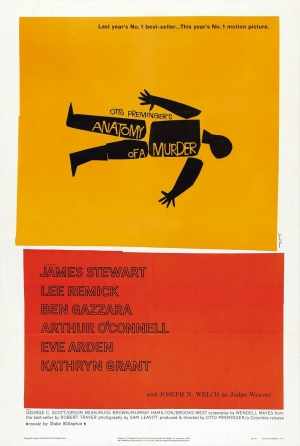
The film’s ratio of 1:85:1 also allows the director to introduce clues in the background that viewers can easily miss if they do not pay attention. For example, near the end of the film, Paul asks for the criminal record of one of the witnesses, a prisoner who shared Manion’s cell and was called at the bar by the prosecution. With the record in hand, he moves towards the jury – this opens up our visual field and allows us to notice the two policemen talking in the background. One walks towards the audience and after a brief cut on the witness’s face, we see the policeman leave with McCarthy. With this small detail, Preminger hints that something or someone important will be brought up last minute to help Biegler. Widescreen allows Preminger to play with the mise-en-scène and include details that are essential to build our understanding of the case – this way Preminger can test us on our observational skills. Therefore we see that even the film’s style stresses the importance of looking scrupulously at details in order to interpret their meaning and place them in context. This not only help us to understand the case but teaches us how a film, whatever its subject matter, should be watched – it teaches us more to be more active spectators.
Anatomy of a Murder focuses on the relation between observation and interpretation in both its content and its style. It draws parallels and distinctions between facts and assumptions, knowledge and appearances, and always promotes observation as an essential part of the understanding process. The film observes the American legal system in a scientific and procedural way and offers an authentic portrayal of its inner-workings to the audience based on facts, real-life events and Preminger’s own experience of the court system. Characters are driven by their need to observe in order to understand the truth behind the murder case, and Preminger pushes the audience to be as curious as his characters through his use of a neutral and detailed film style. The audience enters the space of the film and is encouraged to observe the trial and create their own meaning of it, like a jury.
Works Cited
What do you think? Leave a comment.











I saw this movie a long time ago and totally forgot about it. Thanks for reminding me why it was so good! Great job!
Thank you for reading it!
Not showing us any of the violence is what I liked the most about this flick.
Good point. It lets audiences’ imagination undertake the investigation in the same manner as the protagonist.
Great depiction of a courtroom.
The black and white cinematography of this film is so excellent! I love a well shot B&W film! This is a great film.
The Criterion bluray is especially good.
Brilliant film, one of Jimmy Stewart’s best performances but it is also greatly bolstered by a terrific script. I particularly like the ending which strikes the perfect balance between good-natured, humorous rapport to conclude the film on a light note while still retaining a darker undercurrent to the eventual court verdict.
Great article. I’ll have to sit down and watch it some time.
Really fascinating read. Had never heard of it and am now excited really excited to watch it.
The film made me remind of the 12 angry men. This is one of the best films that I had seen about courtroom drama.
I absolutely loved 12 Angry Men. If that’s the case, I’ll have to move this film up on my watchlist!
Really thought-provoking, and brilliantly acted.
My difficulty with this movie is the excessive length: 2h40m. I realize that directors then were experimenting with longer running times, but in a courtroom drama brevity is important. The viewer is not interested in case law from the nineteenth century, they want drama and truth.
I was sitting in my chair, fighting the urge to press the skip button on my remote.
I agree. Witness For the Prosecution (1957) takes 1h56m to tell a story that is every bit as complicated as Preminger’s, while Compulsion (1959) gets the job done in 1h43m.
Watching it in 2015 is still entertaining.
I expected much more from this movie. Instead I found it boring, uninteresting, failing to engage. One problem was that I could not feel anything for anyone concerned. Both the accused and his wife were unlikeable – and the murder victim we never got to see at all, as there were no flashbacks.
Having just watched the movie, I felt like there was gonna be some climatic scene where Stewart realized that he had been actually been wrong. Seems like anatomy of a murder seems like an appropriate name for a movie about someone getting away with a murder.
I wasn’t bored, but there was so much that seemed unnecessary and distracting…Duke Ellington’s cameo, to name just one egregious example. Definitely NOT a tight movie by any means.
Quite perfect and totally unpredictable film. Thanks for the excellent analysis.
Yes, one hundred percent. I have seen the movie a few times. It left the same impression about the court system on me. An attorney who enjoys fishing and a buddy who enjoys drinking gives it a down to earth touch. It provides enough fire to keep one guessing and hold a person’s attention until the end.
Excellent discussion of perspective and how everything really comes into play
This is an excellent piece, the way in which you dissect the film presents a compelling analysis and pays homage to the artistic intentions of the film. I especially love the section about her eyes as being “windows to the soul”…well done!
I may have seen this film 3 or 4 times now. Yes, it’s dated. 1959. BUT.
This film deserves the highest praise.
Very interesting observations and analysis. I must go see this film ASAP! Thanks for the awesome article!
It is so uneven it’s ridiculous. There are some great scenes in the courtroom, but all in all it’s a terrible film.
Well, “terrible” is a little too harsh, but I was quite disapponted, too – after a very, very long movie I was wondering “what’s the point?!”
Fantastic classic courtroom drama.
Another Otto Preminger film you may all be interested in checking out is “Bonjour Tristesse” (1958). It stars David Niven, Deborah Kerr and the oft-vilified and rather polarizing Preminger protégé Jean Seberg. I had to revisit it after reading this wonderful article on “Anatomy of a Murder.” “Bonjour Tristesse” — the English translation is “Hello Sadness” — was the first movie I saw in which the aspect ratio of a film informed my understanding of it.
Yes! I haven’t seen the film but I recommend the book, it’s gorgeous. Thanks for the suggestion 🙂
The thing that seems most interesting to me is the celebration.
I love the film but feel that Preminger is almost too didactic in what he presents about the justice system.
I learned that Hitchcock walked onto almost every one of his film sets with a completely finished film; being on set was where the translation occurred, as he had every bit of his film on paper. I wonder what effect that had on this film in particular, especially after you mentioned the clues hidden in the image and how the aspect ratio was utilized to in ways to help hide the clues. I love that you mentioned so much about how the camera, and likely the film as well focused on the observational technique, and how that plays into not only the plot of the film, but engaged the viewer on a whole different level. I haven’t seen the film yet but I intend to, but this made me want to watch is much sooner that I originally intended.
Yeah. Just realized that I completely Biffed it on the director. Wow, it’s late. Apologies to the film community. I must have been thinking Dial M For Murder somehow. How embarrassing.
Haha don’t worry, it happens! Thanks for your nice comment though and hope you will enjoy the film.
That sounds like a really creatively done movie. And very nice article about said movie.
A fascinating and enlightening examination of this film. Thanks for sharing your insights!
Did you notice how the camera bounces as it rides along side of the moving cars? Was this intentional or simply a function of the method? When the camera vehicle stops and follows the retreating car, the bouncing stops.
Another issue, while Otto may have had extensive knowledge of the legal system, such theatrics in the court are simply not tolerated. A courtroom is a very dry and functional place. At least in Canada, you would never get away with these antics. It is true, however, that lawyers will find all kinds of ways of “reaching” the judge. Many a lawyer will know judges personally. The interplay of personalities is as important and the law.
Very nicely done. I enjoyed these observations and they both inspired me to rewatch the film and enhanced my viewing of it. Thank you!
This seems to be the procedural version of 12 Angry Men.